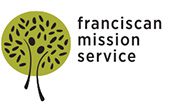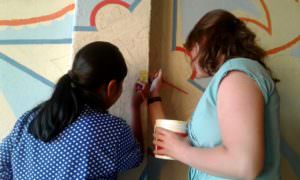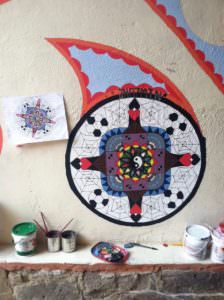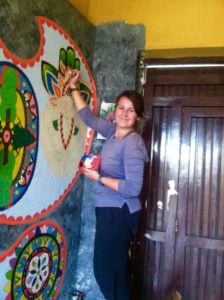Beneath the Paint
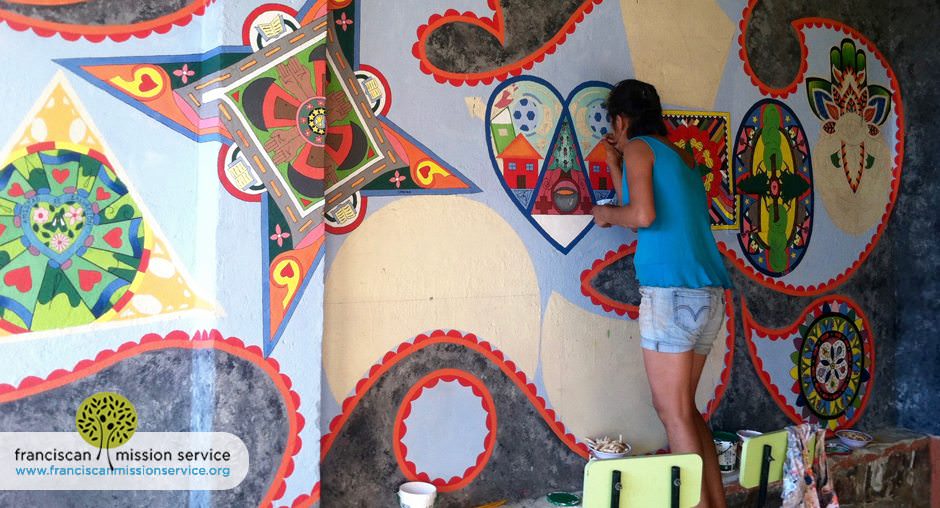
Editor’s note: Missioner Allison Dethlefs reflects on the transformative process of an art project with the girls at Nuestra Casa in Cochabamba, Bolivia.
It started out as a boredom prevention project. The girls at Nuestra Casa—a home for girls who have experienced sexual violence or abuse—were about to start their month-and-a-half of winter vacation (in June and July), and were looking for some extra activities to keep busy. So, when I suggested to the home’s director that I help the girls paint a mural, she jumped right on board with the idea.
At first, all we had for the mural was a 31-foot wall.. Then there was the design. I wanted to come up with something that would allow each girl to be creative in her own space, but that would ultimately come together to create a single, connected image. As is usually my way, I ended up settling on perhaps the most complicated idea possible: mandalas.
From this inspiration, the overall plan was to paint a girl on the far left of the wall holding and gazing into a large sphere, which contained a mandala symbolizing the home. Then, the main mandala would burst open on the opposite side, leading to a stream filled with all the girls’ mandalas covering the rest of the wall. These would symbolize the girls hopes and dreams creating a colorful and brilliant future out of a darkened past.
Over the course of several weeks, I sat down with each girl and helped her design her own mandala to represent her hopes and dreams, her personality, her likes and talents—in short, herself. Then, together, we began the arduous task of drawing and painting each mandala on the wall. This work has been a slow lesson, for everyone involved, in patience and persistence. Each mandala takes about six to ten hours to complete, which has meant a quadrupling of my work schedule at the home. Some girls are more enthusiastic painters than others, and my obsessively perfectionistic tendencies have been put to the extreme test as I deal with general adolescent sloppiness and inattentiveness to detail. At times, it can be hard to keep myself from fixing and touching up every crooked line and messy shape.
However, as the wall has begun to blossom with color, what started as a simple painting project has become so much more. As I spend hour after hour of one-on-one time with the girls, my relationship with them has deepened tangibly. I have heard all about typical teenage boy trouble and squabbles with friends. I’ve learned about siblings and parents, school and hobbies. I have switched from the role of teacher to that of confidant and friend. And on certain days, I hear stories about the unspeakable tragedies, betrayals, and suffering these girls have survived and overcome.
Being there day in and day out, instead of simply teaching two Zumba classes a week as I used to, has made such a difference. In four months’ time, the girls and I have spent over 100 hours on the mural. Despite all of our efforts, we’re only about halfway done, but at the end of the day, the visible progress only shows a fraction of all that has been shared, and poured into this project.
Each day, as I laugh and sing and share with these girls, and as that once blank wall continues to transform into the beautiful monument I think it was always meant to be, I realize again and again that the mural itself is really just as symbolic as the images each girl wove into her design. The true beauty and worth of this “boredom prevention project” are all the marks that will be left beneath the paint: the bonds created by mornings and afternoons spent dreaming, supporting each other, and sharing ourselves.
Indeed, as I look to the end of my time in Bolivia, I can’t help but think that in every sphere and facet of my rich and beautiful life here in Cochabamba what’s beneath the paint will be the greatest legacy of all.
Reflection question: In what way is your personality woven in and expressed throughout your daily life?
Tagged in:
